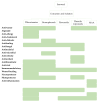Seaweed Phenolics: From Extraction to Applications
- PMID: 32722220
- PMCID: PMC7460554
- DOI: 10.3390/md18080384
Seaweed Phenolics: From Extraction to Applications
Abstract
Seaweeds have attracted high interest in recent years due to their chemical and bioactive properties to find new molecules with valuable applications for humankind. Phenolic compounds are the group of metabolites with the most structural variation and the highest content in seaweeds. The most researched seaweed polyphenol class is the phlorotannins, which are specifically synthesized by brown seaweeds, but there are other polyphenolic compounds, such as bromophenols, flavonoids, phenolic terpenoids, and mycosporine-like amino acids. The compounds already discovered and characterized demonstrate a full range of bioactivities and potential future applications in various industrial sectors. This review focuses on the extraction, purification, and future applications of seaweed phenolic compounds based on the bioactive properties described in the literature. It also intends to provide a comprehensive insight into the phenolic compounds in seaweed.
Keywords: bromophenols; flavonoids; phenolic terpenoids; phlorotannins; polyphenolics bioactivities; polyphenolics extractions; seaweed polyphenolics.
Conflict of interest statement
The authors declare no conflict of interest.
Figures












References
-
- Fallarero A., Peltoketo A., Loikkanen J., Tammela P., Vidal A., Vuorela P. Effects of the aqueous extract of Bryothamnion triquetrum on chemical hypoxia and aglycemia-induced damage in GT1-7 mouse hypothalamic immortalized cells. Phytomedicine. 2006;13:240–245. doi: 10.1016/j.phymed.2003.10.009. - DOI - PubMed
-
- Ferreres F., Lopes G., Gil-Izquierdo A., Andrade P.B., Sousa C., Mouga T., Valentão P. Phlorotannin extracts from fucales characterized by HPLC-DAD-ESI-MS n: Approaches to hyaluronidase inhibitory capacity and antioxidant properties. Mar. Drugs. 2012;10:2766–2781. doi: 10.3390/md10122766. - DOI - PMC - PubMed
Publication types
MeSH terms
Substances
LinkOut - more resources
Full Text Sources

